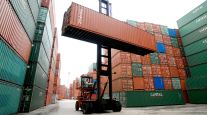Intermodal Cargo Buoys Truck/Rail Freight Growth
This story appears in the Dec. 19 & 26 print edition of Transport Topics.
Truck/rail freight’s steady growth trajectory continued in 2011, buoyed by domestic intermodal service that apparently continued to attract more over-the-road freight as truck capacity tightened.
Late in the year, domestic intermodal cargo was running more than 6% ahead of 2010 levels, based on Intermodal Association of North America statistics. That activity outpaced indexes of dry van and refrigerated freight compiled by American Trucking Associations, which were little changed from 2010 levels, as of early December.
“Almost every shipper I’ve talked to is looking at how they can increase intermodal,” Ike Brown, vice chairman of motor carrier NFI Industries, told Transport Topics in early November, citing capacity concerns.
The shift has been steady — over the past five years, domestic intermodal business is up about 15%, and dry van truckload is off about 5%.
Cumulative IANA intermodal volume over three quarters of 2011 reached 10.5 million shipments, creating the prospect that the full year could rival 2007 in truck/rail moves. The year 2007 was the second-busiest ever, trailing only the record set in 2006 of 14.2 million.
Domestic intermodal’s growth was counterbalanced by a third-quarter drop-off in international cargo, which helped to push intermodal to the 2006 record volume.
That year, Asian imports and other international intermodal accounted for 60% of truck/rail freight. By 2011, that share was about 53%.
International cargo slipped 2.6% in the third quarter as imports eased, reversing a year-to-year gain of 7.1% in the first half of 2011.
Still more domestic freight is expected to use intermodal, said such railroad officials as James Squires, chief financial officer at Norfolk Southern, which already moves about 3 million truck/rail loads annually.
“We believe we will have the opportunity to divert very substantial truck volumes off the highway,” he said last month at an investor conference as the railroad builds five more intermodal terminals.
Earlier this month, the Federal Motor Carrier Safety Administration said it has created a new system to more accurately assign safety violations that are found on chassis during roadside inspections.
That system was the latest step in implementing federal chassis safety rules meant to assign violations to the party with legal responsibility for equipment condition.
American Trucking Associations’ Intermodal Motor Carriers Conference has been pressing for FMCSA’s revisions, asserting that truckers still were being charged for violations that should have been assessed against the chassis provider.
As the year wound down, intermodal motor carriers also faced continued uncertainty about chassis supply for international cargo.
Among the 20 largest ocean carriers, some were charging for chassis that could be used to haul any steamship line’s boxes. Others, such as APL, offered chassis for free.
Meanwhile, some ocean lines put most chassis in a nationwide pool operated by an affiliate of their Ocean Carrier Equipment Management Association trade group.




